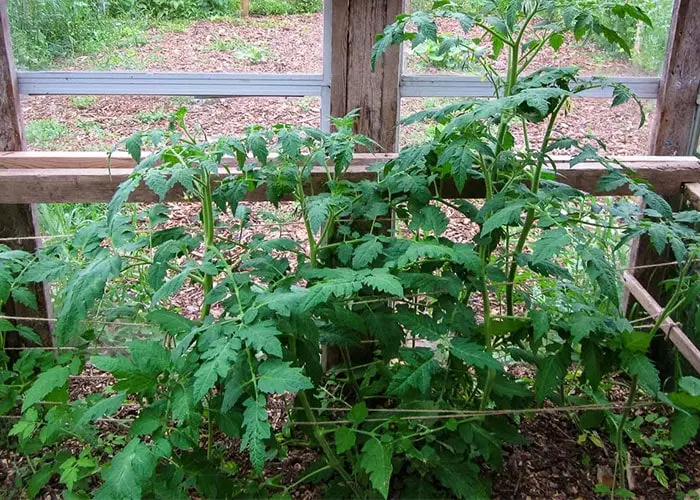This post may contain affiliate links, my full disclosure can be read here. As an Amazon Associate I earn from qualifying purchases.
Trying to decide between determinate vs. Indeterminate tomatoes to grow in your garden can be a little confusing. There are so many varieties of tomatoes that are divided between bush and vining types. Learn how to tell them apart and what care they need so you can pick the perfect type of tomato for your vegetable garden.
What’s The Difference Between Determinate and Indeterminate Tomatoes?

Determinate tomatoes are what’s called bush tomato plants. This means they grow to a set height normally 3-4 feet. Bush tomatoes stop growing once flowers have formed on the top bud. Then they set their fruit at the same time.
Indeterminate tomato plants are also called vining tomatoes. They will keep growing until the frost kills them in the fall. They can easily reach 6 feet in height in the garden but can reach height up to 12 feet with the right care.
Indeterminate tomatoes and set fruit more gradually for a longer but slower harvest.
While that is the basic definition of a determinate and indeterminate tomato there are many pros and cons to each type of tomato plant.
Let’s look at these closely so you can decide the best type of tomato plant to grow in your garden.
Determinate Tomato Care

Determinate tomatoes often called bush tomatoes are much smaller plants than indeterminate types.
Some varieties grow to be only 12 inches like Tiny Tim cherry tomatoes up to about 4 feet tall for other types of cherry, slicers and paste tomatoes.
This means you can find the perfect tomato to grow in any space you have in your vegetable garden or containers.

Bush tomatoes form flowers on the tips of the branches once the plant has reached its full height. Once these flowers form on the growth tip at the top of the plant it can no longer continue to grow.
At this time the plant puts its energy into producing fruit instead of growing more foliage.
Harvesting
While it will depend on the tomato variety you decide to grow, overall bush tomato plants will set fruit earlier in the growing season than vining tomatoes do.
They also ripen faster and since most of the tomatoes ripen at about the same time. This makes them a great choice to grow if you want to can large batches of tomato sauce rather than many smaller amounts over the summer.
Pruning
Determinate tomato plants also don’t need pruning. If you try to prune your bush tomatoes you may end up reducing the amount of fruit the plant produces.
If you like you can remove some of the bottom branches to help stop the spread of fungus spread from the soil but try to avoid removing suckers and thinning the plant out.
Supports
Bush tomato plants are often supported with tomato cages. But I can’t recommend those small tomato cages you often find in garden centers they just are not strong enough to hold a large bush plant without falling over.
Although they do make good supports for small cherry tomatoes and peppers.
Instead use a larger, heavy-duty tomato cage. You can even make your own out of fencing wire, just make sure the holes are large enough to easily get your hand through for picking.
Placing 4 wooden stakes in the ground around the plant and then wrapping string around to make a cage also works.
But my favorite method is to use the Florida weave support style with bush tomatoes.
Indeterminate Tomato Care

Indeterminate tomatoes grow very differently from determinate types.
These grow as long vines that will continue to grow all year until you either cut back the growing end, remove the plants, or the frost kills them in the fall.
Vining tomatoes produce flower clusters along the sides of the plants stem instead of the growing tips like bush tomatoes do.
This small difference is what keeps the indeterminate tomato varieties growing taller throughout the growing season.
Pruning Vines
Vining tomatoes respond well to pruning and many will remove suckers from the plants so that only one vine is left to grow.
This is because indeterminate tomatoes are such vigorous growing plants that they can become overcrowded without pruning.
Do you have to prune vine tomatoes? No, you don’t but it can improve air circulation and that may help to reduce the chance of fungus problems on your plants.
We will often prune the plants heavier when they are young, and then let one or two suckers from the bottom grow up to become full plants. This works well as a balanced approach increasing yields from our plants in a smaller space.
Once the vine has set its first flower cluster you can remove the leaves and branches below it.
Continue to remove suckers from the plant and as you harvest a set of tomatoes you can remove the leaves and stems below it.
This will help to keep the tomato plant from getting too bushy and put more energy into setting and ripening fruit.
Fruit Set
Their fruit starts to set near the bottom of the plant and as it continues to grow fruit will set in clusters going up the vine.
Normally, the tomatoes set near the bottom will ripen first and then they will continue to ripen and set new fruit as the vine grows.
This gives you a long but slower harvest from each plant.
If you want a large harvest of tomatoes at the same time you will want to grow more indeterminate plants or go with a determinate type instead.
Vining tomatoes are perfect to grow for a steady supply of fresh eating tomatoes in the summer or if you want to put up tomatoes in smaller batches.
Support
Vining tomatoes need a larger growing area since they will continue to grow vertically all summer. You will want to make sure you have a strong trellis to support the growth.
I’ve seen vining tomatoes easily reach 6 to 8 feet tall in our northern garden zone, while in a greenhouse many varieties can grow much taller.
There are many options for trellising vining tomatoes. Nylon mesh trellis works very well, hog panels are a strong and long-lasting option, even heavy-duty string like bailer twine works very well to make a string trellis.

You can also use the Florida weave method with vining tomatoes as long as you make sure the stakes are in the ground 18 inches.
The most important thing is that your tomato support is tall enough and strong enough to support the plants.
How To Decide If You Should Grow Bush Or Vine Tomatoes

With two main types of tomatoes bush and vining and so many varieties within both, it can be difficult to describe what to grow.
The best thing to do is to stop and think about why you are growing tomatoes.
If you want to can tomato sauce and would like to have a large harvest over a few weeks in the summer then determinate tomatoes could be the best type for you.
If you would prefer to can smaller batches of tomatoes over a longer period or have fresh eating tomatoes all summer then indeterminate tomatoes would be a better option.
Also, keep in mind how much space and time you have for growing tomatoes.
Vining tomatoes will need more time for pruning and tying to support as they grow. While bush tomatoes can be caged early in the season, don’t need pruning just basic care until harvest time.
More Tomato Tips
- Why Tomatoes Split And How To Stop It
- Tips To Prevent Blossom End Rot
- Controlling Tomato Hornworms
- How To Save Tomato Seeds

Kim Mills is a homeschooling mom of 6 and lives on an urban homestead in Ontario, Canada. Blogging at Homestead Acres she enjoys sharing tips to help you save money, grow and preserve your own food.
